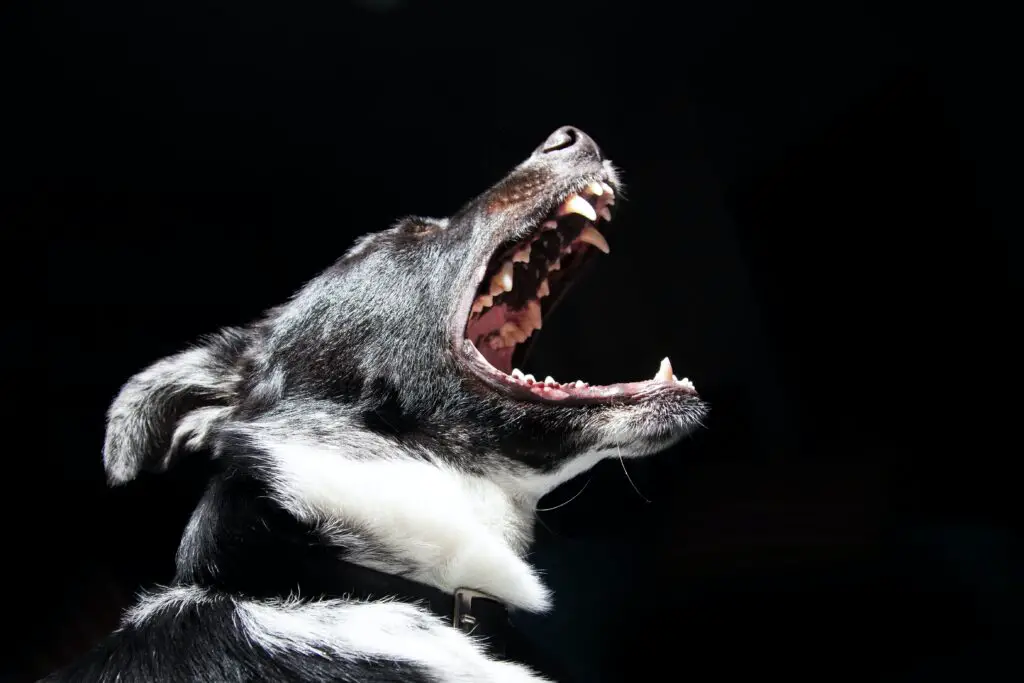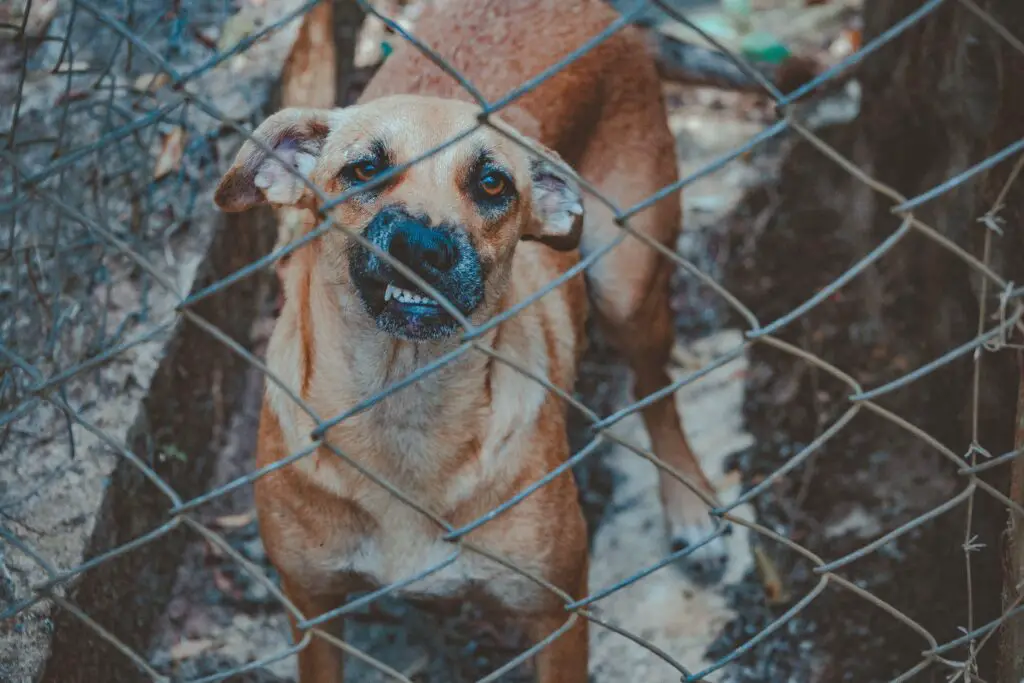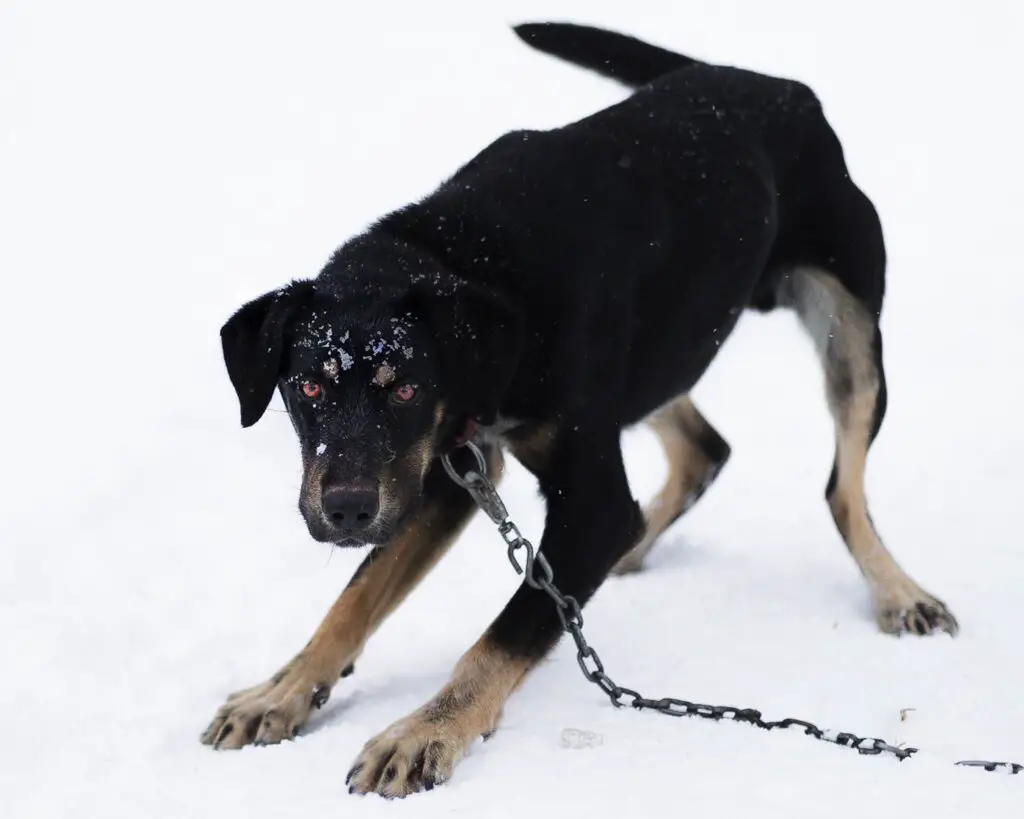Dealing with a neighbour’s dangerous and aggressive dog can be a difficult and stressful situation, especially when they live next door. Dangerous dogs can pose a threat to both people and other pets in the neighbourhood, and it is essential to take necessary precautions to ensure the safety of everyone involved.
Dealing with a neighbour’s dangerous dog in the UK can be challenging. Talk to your neighbour first, contact the local council, keep a record of incidents, install barriers and consider legal action if necessary. Prioritise safety and seek help from relevant authorities.
This article provides an in-depth guide on dealing with a neighbour’s dangerous and aggressive dog in the UK, including what to do if you encounter one, how to take preventive measures to keep your property and family safe and how to report a dangerous dog.
What is Classed as a Dangerous Dog in the UK?
In the UK, there are specific breeds that are banned under the Dangerous Dogs Act 1991, including the Pit Bull Terrier, Japanese Tosa, Dogo Argentino, and Fila Brasileiro. However, it’s essential to understand that any breed of dog can be dangerous, and it is often their behaviour that makes them a threat, not their breed.
Understanding the Threat of Dangerous Dogs
Neighbours and their pets are a part of our everyday lives, but what happens when a neighbour’s dog becomes a potential threat?
Understanding the risks and how to deal with dangerous dogs in your neighbourhood is crucial for the safety and well-being of yourself, your family, and your neighbours.
The threats posed by a neighbour’s dangerous and aggressive dog in the UK can be significant and varied. These threats can include:
- Attacks on people: Dangerous dogs can pose a serious risk to the safety of people. They can cause severe injuries, and in some cases, fatalities. Children and the older generation are particularly vulnerable to dog attacks.
- Attacks on other animals: Dangerous dogs can also pose a threat to other animals, such as cats, livestock, and wildlife. Attacks on other animals can result in significant harm or even death.
- Psychological harm: Even if a dog does not physically harm someone, the fear and anxiety caused by an aggressive or threatening dog can have a significant psychological impact on individuals.
- Legal consequences: Owners of dangerous dogs can face legal consequences, including fines, imprisonment, and a criminal record. Additionally, if a dog is found to be a banned breed, it may be seized and destroyed.
Causes of dog aggression include fear, territorial behaviour, dominance, and protecting their owners or puppies. It is crucial to identify the triggers of a dangerous dog, such as unfamiliar people, children, and other pets.
When dogs display aggressive behaviour, it is usually accompanied by specific body language, such as growling, barking, and showing their teeth.
It is important to remember that not all dogs are dangerous, and many dogs are well-behaved and loving companions. However, it is essential for dog owners to take responsibility for their pets and to ensure they do not pose a threat to others.
This includes proper socialisation and training, responsible ownership, and following the laws and regulations related to dog ownership, such as the Dangerous Dogs Act.

Taking Preventive Measures
Taking preventive measures can help prevent dangerous dog incidents from occurring. Here are some safety tips to follow:
- Always supervise your pets when outside, especially when close to other dogs.
- Keep your property secure to prevent other dogs from entering and potentially causing harm.
- Teach children the proper way to interact with dogs, including not approaching unfamiliar dogs or teasing them.
- Avoid direct eye contact with a dog that appears to be aggressive.
- If a dog is acting aggressively, do not run away. Stand still, and avoid making any sudden movements.
Dangerous Dogs Act 1991 Summary
In the UK, there are various local laws and regulations that govern the ownership and control of dogs, including dangerous dogs. The Dangerous Dogs Act 1991 is the main legislation that governs dangerous dogs in the UK, and it places a legal obligation on owners to keep their dogs under control at all times.
The law makes it illegal to breed, sell, or give away banned breeds, and it is also illegal to own banned dogs without a specific exemption from a court. If a dog is found to be a banned breed, it may be seized, regardless of its behaviour.
Owners of all types of dogs have a legal responsibility to ensure their pets are well-behaved and do not pose a threat to others. Under the Dangerous Dogs Act, it is a criminal offence to allow a dog to be “dangerously out of control” in public or on private property. This includes attacking people or animals or behaving in a way that makes someone feel threatened or afraid.
Under the act, owners are required to keep their dogs on a lead and muzzled in public places and can face prosecution if their dog causes harm to another person or pet. In addition, local councils also have the power to impose Dog Control Orders, which can restrict the number of dogs a person can keep or prohibit dogs from specific areas, such as parks and beaches.
If a neighbour’s dog is causing a disturbance or posing a threat to your safety, you can make a complaint to the local council. The council will investigate the complaint and may take action against the owner if they believe that the dog is dangerous and not being controlled appropriately. This may include issuing a warning, imposing a fine, or even seizing the dog if necessary
It is important to note that the Dangerous Dogs Act is not without controversy. Critics argue that the focus on specific breeds of dogs is misguided and that more emphasis should be placed on responsible ownership and training. Nevertheless, the law remains in effect in the UK and is enforced by local authorities and the police.
It should be noted that The Dangerous Dogs (Amendment) Act 1997 did make some amendments to the 1991 Act. There is a detailed guide from DEFRA with further information about dangerous dogs and the law that you can access here.
Breaching the Dangerous Dogs Act 1991
Breaching the Dangerous Dogs Act 1991 in the UK can result in severe penalties, including fines and imprisonment. Here are some of the penalties for breaching the Act:
- Imprisonment: The Act provides for a maximum sentence of six months imprisonment for the owner of a dog that is dangerously out of control in a public place, which results in an injury. If a victim dies from an attack then the sentence can be up to 14 years imprisonment.
- Fines: A court can impose a fine of up to £5,000 for the owner of a dog that is dangerously out of control in any place, including private property, which results in an injury.
- Destruction of the dog: In severe cases, a court can order the destruction of the dog that is deemed dangerous or out of control.
- Criminal record: A conviction for a breach of the Dangerous Dogs Act 1991 will result in a criminal record that can affect employment opportunities and travel plans.
It is essential to take the Dangerous Dogs Act 1991 seriously and ensure that your dog is properly trained and socialised.
Owners of dogs that are known to be aggressive or have a history of aggression should take proactive measures to prevent future incidents and comply with the requirements of the Act.
What To Do When You Encounter A Dangerous Dog
Encountering a dangerous dog can be a frightening experience, but there are steps you can take to protect yourself and others.
Here are some things you can do:
- Stay calm: It is essential to remain calm and avoid panicking. Dogs can sense fear and may become more aggressive if they sense you are afraid.
- Do not make eye contact: Avoid making direct eye contact with the dog, as this can be perceived as a challenge or threat.
- Stand still: If the dog is not attacking, stand still and avoid making sudden movements. Dogs are more likely to attack if they feel threatened or if they perceive you as prey.
- Avoid running: Running away from a dog can trigger a chase response, and the dog may become more aggressive. Instead, try to back away slowly and calmly.
- Protect yourself: If the dog does attack, try to protect yourself as much as possible. Use a jacket, bag, or any other object to create a barrier between yourself and the dog.
- Call for help: If you are in danger, call for help immediately. This could be a passerby, animal control, or the police.
- Report the incident: If you are attacked or threatened by a dangerous dog, report the incident to the relevant authorities, such as the local council or the police. This will help to ensure that appropriate action is taken to prevent future incidents.
Remember that prevention is key when it comes to dangerous and aggressive dogs. If you encounter a dog that appears to be aggressive or threatening, it is best to avoid the dog altogether and report the incident to the relevant authorities.
If you’re attacked by a dog, it’s crucial to seek medical attention as soon as possible. Report the incident to the police and animal control, providing as much detail as possible about the dog, its owner, and the attack.

How Do I Report A Dangerous or Aggressive Dog UK?
If you encounter a dangerous dog, or if you are concerned about a dog that is showing aggressive or threatening behaviour, it is essential to report it to the relevant authorities. Reporting a dangerous dog can help to ensure that appropriate action is taken to protect the safety of people and other animals.
Here is how to report a neighbour’s dangerous or aggressive dog in the UK:
- Contact your local council:
The first step is to contact your local council dog warden service. They are responsible for dealing with dangerous dogs in your area. You can find the contact details for your local dog warden here.
- Provide details:
When you report a dangerous dog, be prepared to provide as much detail as possible, including the location of the dog, the owner’s details, the breed (if known), and a description of the dog’s behaviour.
- Provide evidence:
If possible, take photos or videos of the dog, and keep any records of incidents involving the dog. This evidence can be useful when investigating the case.
- Follow up:
If you do not receive a response within a reasonable time frame, follow up with the council to ensure that action is being taken.
- Contact the police:
If the dog poses an immediate threat to safety, or if a crime has been committed, you should contact the police. Dial 999 in an emergency or 101 for non-emergencies.
Remember that it is important to report any dangerous dog behaviour, even if it has not resulted in an attack or injury. This can help to prevent future incidents and ensure the safety of the community.
Dealing with a Neighbour’s Aggressive Dog on your Property
Dealing with a neighbour’s dangerous or aggressive dog on your property can be a challenging situation.
Here are some steps you can take:
- Talk to your neighbour: The first step is to talk to your neighbour about the situation. Try to approach them calmly and respectfully and explain your concerns. It is important to keep the lines of communication open to find a mutually agreeable solution.
- Contact your local council: If your neighbour’s dog is causing a nuisance or is a danger to your safety, you can contact your local council. They have the authority to investigate and take action to address the situation.
- Keep a record: It is important to keep a record of any incidents involving your neighbour’s dog, including the date, time, and details of what happened. This record can be useful when making a complaint to the council. I have a guide on how to collect evidence for a neighbour dispute that you can read here.
- Install barriers: If possible, install barriers on your property to prevent the dog from entering, such as a fence or a gate.
- Consider legal action: If the situation cannot be resolved, you may need to consider legal action. This could involve seeking an injunction or taking the matter to court. I have a guide on instructing a neighbour dispute solicitor that you can read here.
Seeking Professional Help if You Have an Aggressive Dog
If you are concerned about the behaviour of your dog, you should seek professional help as soon as possible before it turns into a serious problem.
There are several places in the UK where you can seek professional help for an aggressive dog in the UK. Here are some options:
- Your veterinarian: Your veterinarian can provide advice and may refer you to a specialist behaviourist.
- A certified dog trainer: A certified dog trainer can work with you and your dog to address aggressive behaviour and provide training to prevent future incidents.
- The Association of Pet Behaviour Counsellors (APBC): The APBC is a professional association for behaviourists and trainers who specialise in pet behaviour. They can provide a list of registered behaviourists in your area.
- The Royal Society for the Prevention of Cruelty to Animals (RSPCA): The RSPCA can provide advice and may refer you to a specialist behaviourist.
Remember to choose a reputable professional who has experience in dealing with aggressive behaviour. It is important to address aggressive behaviour as soon as possible to ensure the safety of your dog and others.

Conclusion
In conclusion, dealing with a neighbour’s dangerous and aggressive dog in the UK can be a difficult and concerning situation.
By following the appropriate steps, such as talking to your neighbour, contacting the local council, keeping a record of incidents, installing barriers, and considering legal action if necessary, you can take proactive measures to address the situation.
Remember, reporting a dangerous or aggressive dog is important to prevent future incidents and protect the community.





Leave a Reply